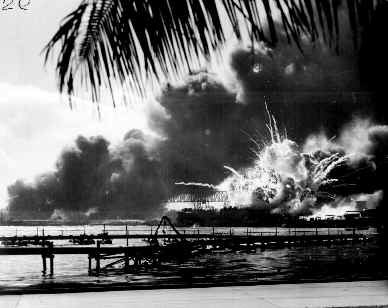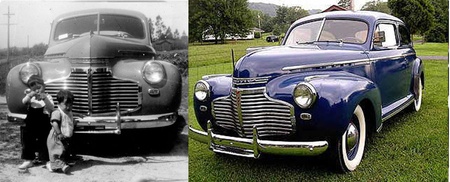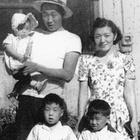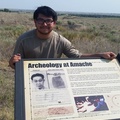I imagine it was a beautifully clear December morning, our Mommy’s birthday, a “day of rest” Sunday, and a new Chevy coupe parked out in front on Geary Street! Daddy didn’t need any more reasons to decide, “Let’s take a drive out to the country!”
Our father, Sam Masami Ono packed my brother Stanley Kazumi, almost-3 and me, almost -2, (we were both born in January), our Auntie Yuki Okamura and of course, our mother Kimiye, the “birthday-girl” into the shiny 1941 Chevrolet for a drive north across the Golden Gate Bridge to Marin County. Marin is just south of Sonoma County where our father and his siblings were born and where Jiichan and Bachan Ono still lived with his three brothers in Graton, close enough should we decide to visit.
The drive across the Golden Gate Bridge is an exciting adventure, especially for us kids, motoring under the gigantic orange twin towers that hold the sweeping massive braids of cable that suspended the bridge roadway 220-feet above the sea entrance to the San Francisco Bay. At that time it was still the longest single-span suspension bridge in the World. Today, it is surpassed by eight other bridges.
The car’s AM-radio was playing some of the top-ten popular hits, among them could have been: Amapola by the Jimmy Dorsey Orchestra, You Are My Sunshine by Gene Autry and Stardust by clarinetist Artie Shaw.
Nearing noon, a news bulletin crackled from the radio abruptly interrupting the music and our pleasant mood. “Pearl Harbor in Honolulu, Hawaii is being attacked by a wave of Japanese warplanes!” Visiting Graton was definitely out and spending anymore time in Marin, not appealing anymore. In shock, our parents decided it best we head back home to San Francisco’s Japantown.
How do I remember or imagine all of this being only almost two-year-old at the time? Well, the fact is, December 7, 1917 is our mother’s birthday. And, in a 1983 audiotape recording of my mother, she told me of that particular Sunday drive. (audio clip of Kimiye (Okamura) Ono and son, Gary) - transcript below:
GO: What were you doing when the, when the attack of Pearl Harbor was announced? How did you find out?
KO: Oh . . . it was a Sunday afternoon. We were riding around Marin County.
GO: You and Daddy?
KO: Uh-huh
GO: Were we with you? Ah, the kids with you?
KO: Yeah and I think Auntie Yuk too. Somebody was with us.
GO: You heard it on the car radio?
KO: Uh-huh
GO: What was your . . . how did you feel?
KO: I didn’t believe it! . . .until we got into San Francisco and heard it (again) on the radio.
GO: Were you and Dad visiting anyone?
KO: No, it was just a Sunday drive.
GO: Did you come back right away because of the news? KO: Uh-huh
Only recently did I connect a group of pictures in our late Auntie Yuki’s photo album to that particular day. Pictures we kids have looked at over and over throughout our childhood years. Now these pictures seem to grow more relevant as I’ve learned to make connections to people, time and place. In addition to the pictures showing my brother and me with the car, there was one showing our aunt standing by an oblique rear view of the car and on the same album page was a picture of our mom and aunt holding Stanley and me.
By enlarging the pictures showing the front of our car, I was able to make-out that the car was a Chevrolet. How do I know it was a 1941 Chevrolet? I typed “40s Chevrolet” in the search the Internet web box and discovered that the pictures of the 1941 Chevrolets positively matched our car.
Compare the car grill in picture (L) showing Stanley and me in front of the car with the picture to the right of a 1941 Chevrolet called “Mikes 41.” I also communicated directly by email with a 1941 car owner, Roger Garret in Bloomington, Illinois and sent him attached copies of my aunt’s pictures.http://1941chevrolet/friendscars7.html Roger Garret’s response, “The car you and your brother and aunt are standing in front of is a 1941 Chevrolet Special Deluxe, two door COUPE - a more sought after model than my Special Deluxe, two door TOWN SEDAN. They are almost identical except for the more pronounced slope and shorter top on the Coupe.”
Not to further beat a long-gone 90-horse powered car, which are what the engines were rated at, but check out the restored 1941 Chevy coupe (L) and a Sedan (R). You can see how we reached our conclusions. It may be just a hopeful stretch, but I strongly believe that the pictures in my Aunt’s album could have been taken on our mother’s birthday, the day of our Sunday drive – “A Day That Will Live in Infamy!” December 7, 1941.
During the confused and anxious times that followed our mother’s 1941 birthday, the Pearl Harbor attack and the declaration of war against Japan, curfews, media and public hysteria, etc., voluntary relocation was permitted for families to get out of San Francisco, designated a Military Zone A. The belief was that we would not have to face evacuation out of California if our families moved to Zone B. In our case, inland to our grandfather’s Cortez Colony farm being managed by his eldest Nisei son, Uncle Hiroshi Okamura and his family near Turlock.
Our father and his brother-in-laws must have made the decision and executed the move because their Issei father, father-in-law and the patriarch was arrested shortly after the Pearl Harbor attack and was being held in a temporary Immigration Service facility, a co-opted Jewish Center in South San Francisco, along with other key Japanese community leaders. He was not to be seen by the family for over two years while being shuffled through four different U.S. Justice Department Enemy Alien prison camps, ending up in the one in Santa Fe, New Mexico.
I imagine the 41’ Chevy Coupe was one of the cars with others used in a caravan along with the 1940 Chevrolet (my father is shown standing behind in an earlier picture) to move our Ono and Okamura family inland. I believe this 1940 car belonged to the Okamura family.
Much to our frustration, the military later changed its mind about evacuating only the militarily sensitive zones and ultimately ordered the entirety of the three western states’ Japanese population evacuated to ten hastily-built prison camps located in the “badlands” of the USA.
At least the bulk of our family was together when we were first evacuated to an Assembly Center in Merced, not far from Cortez, and then a few months later to the “permanent” camp near Granada, Colorado, later named Amache, one of the ten War Relocation Authority concentration camps.
Our mother had to deliver our sister, Sandra Yoko on August 5, 1942 in the crude medical facility on the Merced County fairgrounds, just a month before we were all put on old trains to Colorado, just in time to face the freezing cold winter months ahead in cheap and poorly built barracks in Amache.
It’s not hard to realize why our mother’s health was never as vigorous during the war years as when she was growing to healthy womanhood in San Francisco. Recorded in the later published, Amache Center Chronology , on her very next birthday, December 7, 1942, the “Mercury falls to 10-degrees Fahrenheit.” Another not so happy birthday for our mother, I imagine?
© 2009 Gary T. Ono











